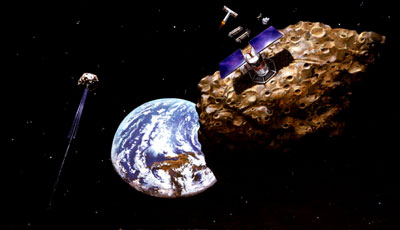Near Earth asteroids: the third optionby Jeff Foust
|
| The debate, has been predicated on the belief that the Moon and Mars are the only two destinations for humans beyond Earth orbit for the foreseeable future. |
President Bush’s new space initiative appears to have resolved this debate, at least for the near term, by emphasizing a human return to the Moon, while offering Mars advocates a consolation prize of eventual Mars expeditions at some point beyond 2020. While the Bush administration may be set on this new initiative, there is no guarantee that this vision will ever become reality. Public opinion is, at best, mixed on this plan, with many concerned about the high costs—real or perceived—such a plan entails. With some members of Congress, including some conservatives, expressing concern about rising budget deficits, this new plan will be subject to considerable Congressional scrutiny in the weeks to come. Even if it survives this near-term challenge, a new president taking office in 2009, let alone 2005, could dramatically reshape—or stop—the plan with a minimum of wasted effort even if it is carried out as planned over the next five years. (See “Looking beyond vision”, January 19, 2004.)
The plan, and the overall debate, has been predicated on the belief that the only two destinations for humans beyond Earth orbit for the foreseeable future are the Moon and Mars. It turns out this is not necessarily the case. A small group of people, including planetary scientists and former astronauts, has argued for a different destination for manned expeditions: one or more of the many asteroids that pass near the Earth. Such missions could be affordable (relatively speaking), visit new destinations, carry out important research, and also set the groundwork for more ambitious missions, like Mars.
Fear, greed, and curiosity
As of the end of last week, there were 2,682 known near Earth objects (NEOs), all but 49 of which are asteroids. (The remainder are comets in short-period orbits that cross or approach the Earth’s orbit.) Of those 2,682 NEOs, 693 are asteroids with diameters of one kilometer or larger. While astronomers believe that they have identified about 70 percent of the population of those large NEOs, the number of smaller NEOs may be vastly larger: over 100,000 with diameters exceeding 100 meters.
In addition to the incomplete catalogs of objects, there are large gaps in our understanding of these bodies. Groundbased telescopes have allowed planetary scientists to crudely classify these objects based on their spectra, and radar observations of some close-passing NEOs have revealed their shapes. Only a handful of asteroids, near Earth or otherwise, have been studied in detail by spacecraft, such as NASA’s NEAR Shoemaker mission that orbited and eventually landed on the NEO Eros. Japan last year launched Hayabusa, the first mission designed to take samples of an asteroid and return them to Earth.
| Asteroids are “literally gold mines in the sky,” Durda said. By contrast, the lunar regolith “has a composition similar to mining slag.” |
Why study NEOs at all? Dan Durda, a planetary scientist at the Southwest Research Institute in Boulder, Colorado, and a proponent of human missions to asteroids, provided a rationale that can be summed up in three words: fear, greed, curiosity. Fear comes form the fact that NEOs have, and will continue to, collide with the Earth. Right now the emphasis is on simply finding NEOs and determining which ones could pose a risk to the Earth in the future. If any do pose a major hazard, then attention will have to turn to mitigating that threat, most likely by deflecting the object’s orbit. That will require significant knowledge of the asteroid and how to operate on it: detonating nuclear weapons, a popular proposal for deflecting asteroids, might instead simply break apart an object that is a loosely-bound rubble pile. “I don’t want to invoke Chicken Little,” said Durda in a recent interview, “but it is a real threat.”
Curiosity comes from the scientific study of NEOs, including work that can only be done on the asteroid itself, preferably by people. Studying these objects, said Durda, offers a window into the origins of the solar system, since these objects are virtually unaltered since the formation of the solar system. Greed is linked to the wealth of resources, from water ice and other volatiles to platinum-group metals, found on asteroids. Scientists and science-fiction authors have long talked about mining asteroids: while there’s no need for these resources on Earth for the indefinite future, such spacebased resources may be useful, if not vital, to any long-term settlement in space. Durda notes that NEOs, the most easily accessible asteroids, are hundreds of times richer in unprocessed materials than the Moon. “They’re literally gold mines in the sky,” he said. By contrast, the lunar regolith “has a composition similar to mining slag.”
